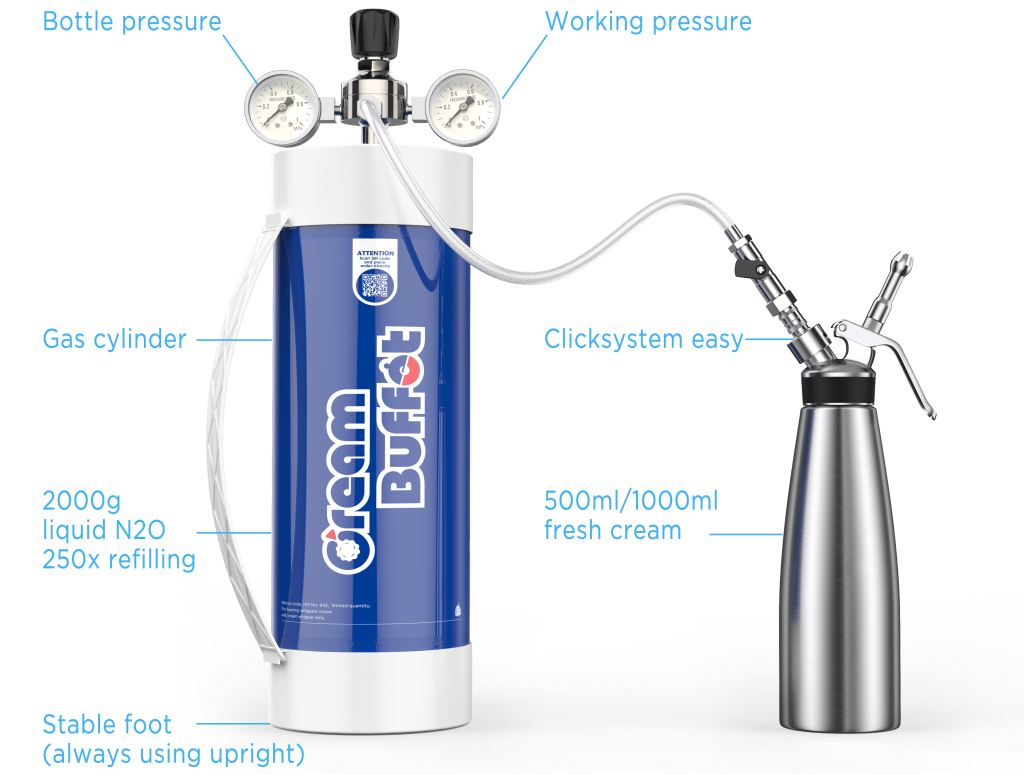“Cream chargers are toxic!” “Cream chargers can explode!” As cream chargers have become a common tool in household kitchens and professional catering establishments, many alarming myths about cream chargers have emerged.These misconceptions not only affect consumers’ decisions but also hinder the proper application of this tool.
Cream chargers do not contain harmful chemicals, are not prone to explosions, and have versatile uses beyond whipping cream, such as in beverages and advanced cooking techniques. Using a cream dispenser is simple, but not all chargers are the same; their quality can vary based on the materials used.
Let’s now analyze and clarify the common myths about whipped cream dispensers from a scientific and professional perspective.
1. How Cream Chargers Work
Cream chargers (scientifically known as nitrous oxide canisters) are filled with pressurized nitrous oxide (N2O) gas. According to physical and chemical principles, when N2O is released into a cream container, it dissolves in the fat and water phases of the cream due to the gas’s solubility properties. As the gas continues to dissolve, countless tiny gas bubbles form inside the cream. These bubbles expand under further action, causing the cream to transform from a dense state to a light, airy texture. This process is called “nitrous oxide injection technology.” By precisely controlling the gas injection amount and conditions, the texture and taste of the cream can be finely adjusted.
2. The 5 Major Myths
(1)Myth 1: Cream chargers contain harmful chemicals
Some people are concerned that nitrous oxide cartridges contain harmful chemicals like diacetyl (2,3-butanedione), which is linked to “popcorn lung” (obstructive bronchiolitis), or propylene glycol. However, from a food safety and quality control perspective, whipped cream dispensers produced by reputable manufacturers strictly follow relevant standards for food contact materials. The main ingredients are food-grade nitrous oxide gas and metals (usually steel) that meet food safety requirements.
For example, according to the EU Food Contact Materials Regulation (EC) No 1935/2004, materials that come into direct contact with food have strict limits on harmful substances. Cream Buffet’s cream dispensers undergo stringent quality control processes during production to ensure that they do not contain any harmful additives or preservatives, making them safe for consumers to use with peace of mind.

(2)Myth 2: Cream chargers are prone to explosion
The rumor that “cream chargers can explode” is widespread and causes many consumers to avoid them. In fact, high-quality nitrous oxide chargers undergo strict quality control and safety testing during manufacturing. For example, according to the American Society of Mechanical Engineers (ASME) standards for pressure vessels, small pressure containers like whipped cream chargers undergo rigorous pressure tests, such as hydrostatic and air pressure tests, before leaving the factory to ensure their safety under normal use conditions. As long as users follow the manufacturer’s instructions, avoid exposing the product to excessive heat (above 50°C), and prevent physical impact or damage, the likelihood of explosion is extremely low.
Additionally, Cream Buffet cream chargers use high-strength, pressure-resistant metal materials to ensure that the container can withstand the pressure of the gas inside. Advanced welding and forming techniques are used to ensure the container’s seal and structural integrity.
(3)Myth 3: Cream chargers are only used to whip cream
Traditional beliefs suggest that nitrous oxide canisters are only for whipping cream. However, their application in the food industry is quite broad:
A. Beverage preparation:
- The foam produced by a cream charger in coffee makes the drink smoother and adds richness to its texture.
- In cocktails, foam not only serves as a unique decoration but also enhances the overall flavor, especially in milk-based cocktails, creating a fuller taste.
- In creative fizzy drinks, N2O interacts with the drink’s ingredients to create delicate bubbles, enhancing both taste and fun.
B. Advanced cooking techniques:
- In molecular gastronomy, N2O injection technology is often used to create foamy sauces, turning ordinary sauces into light, visually appealing, and uniquely flavorful options.
- When making soufflé cakes, a whipped cream dispenser helps make the batter fluffy, creating a special internal structure that results in a lighter and more delicate texture.
Research shows that about 80% of consumers are unaware of the diverse culinary uses of nitrous oxide chargers beyond whipping cream.
It’s important to emphasize that inhaling nitrous oxide is highly dangerous and unethical. Medically, inhaling N2O leads to oxygen deprivation, causing dizziness, nausea, vomiting, and a series of other harmful symptoms. Long-term or excessive inhalation can even cause irreversible damage to the nervous system. Therefore, it is crucial to avoid such misuse and use cream chargers only for their intended culinary purpose.

(4)Myth 4: Using a cream charger is complicated
Many people feel intimidated by the use of nitrous oxide canisters, thinking the process is complex. In reality, using a cream dispenser is a relatively simple process. Here’s how:
- Prepare materials and container: First, ensure that fresh heavy cream is ready, and that the whipped cream charger is clean and dry. Fill the charger bottle with cream, making sure the quantity is within the product guidelines.
- Add flavoring: Add sugar or other flavoring ingredients as desired. Gently shake or stir to combine.
- Install and charge: Insert the N2O charger into the appropriate port on the cream charger bottle, press or twist to release the gas into the bottle. Ensure the connection is tight to avoid gas leakage.
- Shake the mixture: After charging, hold the bottle firmly and shake it at the recommended frequency and amplitude. The gas creates tiny bubbles in the cream, making it fluffy.
During use, always ensure safety by not pointing the charger at yourself or others. Avoid exposing the charger to high temperatures or humidity to prevent damage or performance issues.
(5)Myth 5: All cream chargers are the same
There are many types of nitrous oxide chargers on the market, and some consumers believe there is no difference in performance or quality. However, from a materials science and engineering design perspective, whipped cream chargers made from different materials exhibit significant performance differences.
For instance, stainless steel cream chargers are stronger, more corrosion-resistant, and can withstand greater pressure and temperature fluctuations. They are more durable and less likely to deform or break. On the other hand, plastic chargers are lighter and cheaper but have lower heat and pressure resistance. Additionally, different brands and models of cream chargers may have design differences, meaning not all chargers are compatible with every type of whipping cream.
Cream Buffet’s cream dispensers stand out due to their unique advantages. We use high-quality 304 stainless steel and employ special surface treatments to ensure excellent corrosion resistance, wear resistance, and scratch resistance. Our design optimizes the connection and internal structure to ensure compatibility with common nitrous oxide chargers, allowing for fast, even gas release and improving product performance and user experience.

3. Safety Precautions for Using Cream Chargers
(1)Follow the instructions carefully
Users must strictly follow the manufacturer’s instructions for assembly, usage, cleaning, maintenance, and storage to ensure safe operation.
(2)Choose reliable brands and suppliers
When purchasing nitrous oxide chargers, opt for reputable brands and suppliers, such as Cream Buffet, which invests significantly in product development, production processes, and quality control to meet national standards and industry regulations.
(3)No inhalation
Never inhale nitrous oxide directly from the charger or dispenser. As stated earlier, inhaling N2O can lead to serious health issues and even death.
(4)Handle with care
Handle cream chargers with care to avoid impact or damage, which could cause the container to rupture or leak gas.
(5)Proper storage
Store whipped cream dispensers in a cool, dry, and well-ventilated place, away from heat sources, open flames, and direct sunlight. Do not store them in extremely hot or cold environments.
4. Cleaning and Maintenance of Cream Chargers
(1)Cleaning Frequency
Clean the cream charger after each use to prevent cream residue from deteriorating or blocking the gas path.
(2)Cleaning Method
- Disassemble the charger components and clean them with warm water and a mild detergent.
- For stubborn stains, use a food-safe cleaner and rinse thoroughly.
- Dry the components with a clean towel or let them air dry before reassembling.
(3)Maintenance Tips
Regularly inspect seals and parts for wear or damage, and replace them if necessary. If the charger shows signs of cracks or dents, stop using it and contact a professional for repair or replacement.

5. Common Issues and Troubleshooting
(1)Gas leakage
Stop using the charger if you detect a leak, and check if the connections are tight. If the seal is damaged, replace it.
(2)Unsatisfactory whipping results
This may be caused by insufficient gas, inadequate shaking, or poor-quality cream. Adjust the gas amount and shaking time, or replace the cream.
(3)Clogged charger
If the charger is clogged due to dried cream, soak it in warm water and rinse it thoroughly.
6. Conclusion
Through scientific analysis and clarification of common myths surrounding cream chargers, we’ve discovered that, as long as you understand the proper usage and safety precautions, cream chargers are not only a valuable tool in the kitchen but also open up endless possibilities for your culinary journey.
Join Cream Buffet and explore the limitless potential of cream chargers today!